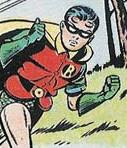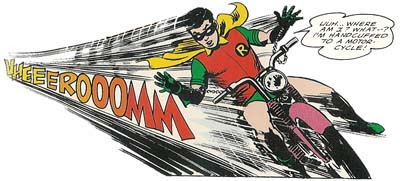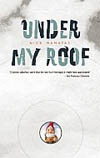 While preparing my next "Reason for Robin" entry, I discovered there's a historical dispute about who came up with the idea of giving the Batman a kid sidekick.
While preparing my next "Reason for Robin" entry, I discovered there's a historical dispute about who came up with the idea of giving the Batman a kid sidekick.
As I recounted back here, Batman writer Bill Finger wanted some sort of partner for the Caped Crusader. In his 1989 memoir Batman and Me, written with Tom Andrae, artist Bob Kane quoted that recollection from Finger and offered no disagreement.
But Kane went on to take credit for the idea of making that partner a boy who fought crooks alongside Batman: Batman departed even further from the vigilante image when I created Robin, the Boy Wonder, to be his partner. . . . Robin evolved from my fantasies as a kid of fourteen, when I visualized myself as a young boy fighting alongside my idol, Douglas Fairbanks, Sr. I imagined that young boys reading about Batman's exploits would project their own images into the story and daydream about fighting alongside the Caped Crusader as junior Batmen.
I thought that every young boy would want to be like Robin; instead of having to wait to grow up to become a superhero, they wanted to be one now. . . .
I named him after Robin Hood, whom I loved as a kid, as played on the screen by Fairbanks. Both Robins were crusaders, fighting against the forces of evil. . . . I even dressed Robin in the tunic, cape, and shoes of Robin Hood's era, and drew his trunks to look like chain mail. . . .

Oddly enough, when I brought the idea to my boss, Jack Liebowitz, he didn't want Robin in the book. He said that Batman was doing well enough by himself and felt we shouldn't tamper with it. Jack also thought that mothers would object to a kid fighting gangsters. He had a point. I said, "Why don't we try it for one issue. If you don't like it, we can take it out."
But when the story appeared, it really hit: the comic book which introduced Robin (Detective Comics #38, April, 1940) sold almost double what Batman had sold as a single feature. I went to the office on Monday after we had gotten the figures and said, "Well, I guess we ought to take Robin out--right, Jack? You don't want a kid fighting with gangsters."
"Well," he said sheepishly, "Leave it in. It's okay--we'll let it go."
There are a couple of problems with that story. First, Bob Kane had a habit of claiming he’d had all the good Batman ideas, and done most of the drawing. To this day Batman stories are legally required to carry the credit "Batman created by Bob Kane." By the date of this memoir, Bill Finger's contributions were already well known, so Kane and his coauthor had to acknowledge them, but he left out someone else.
In 1940 Kane had an assistant, Jerry Robinson, who became a highly respected cartoonist in his own right. In interviews Robinson has made a strong case that he came up with the name Robin, modeled on Robin Hood, and added the medieval details to the Boy Wonder's costume. Robinson has pointed to a specific book of N. C. Wyeth illustrations as his visual inspiration. And unlike his former boss, Robinson has consistently credited Kane and Finger for their contributions to Robin and the rest of the early Batman mythos.
 Therefore, it's significant that Robinson believed that Bill Finger was the first to suggest Batman have a young assistant. In a 2005 interview with Gary Groth published in The Comics Journal, he recalled the team's discussion this way:
Therefore, it's significant that Robinson believed that Bill Finger was the first to suggest Batman have a young assistant. In a 2005 interview with Gary Groth published in The Comics Journal, he recalled the team's discussion this way: ROBINSON: I'm sure it was Bill's idea for adding a boy. That I would attribute to Bill without question. When I came in they were already discussing possible names. So I joined the discussion of the creation. There was nothing on paper yet, nothing but the idea of adding a sidekick. And I know that was Bill's idea to add a sidekick, from the discussion that ensued.
The impetus came from Bill's wanting to extend the parameters of the story potential and of the drama. He saw that adding a sidekick would enhance the drama. Also, it enlarged the readership identification. The younger kids could then identify with Robin, which they couldn't with Batman, and the older ones with Batman. It extended the appeal on a lot of levels.
GROTH: And you're sure it didn't come from Bob Kane?
ROBINSON: No. He fleshed it out, as we all did in discussion, but the idea of adding that character was Bill's.
Kane's reputation for taking credit for Bill Finger's ideas makes it tempting to accept Robinson's version. However, in this case I think Kane was accurate. In his ground-breaking 1968 interview with comics historian Jim Steranko, Finger said: "Bob called me over and said he was going to put a boy in the strip to identify with Batman. I thought it was a great idea." Since that interview was all about uncovering Finger's contributions to the Batman mythos, he had no impetus to give Kane undeserved credit.
 There are a couple of other details in Kane's favor. He had already put a young sidekick into his humorous comic Peter Pupp. And Kane was always the most business-savvy of Batman's two creators, so it makes sense for him to have been thinking about their target market.
There are a couple of other details in Kane's favor. He had already put a young sidekick into his humorous comic Peter Pupp. And Kane was always the most business-savvy of Batman's two creators, so it makes sense for him to have been thinking about their target market.
I therefore think Robinson misunderstood the conversation about a kid sidekick when he entered: Finger had been the first to advocate giving the Batman a partner of some sort, and probably had the most to say about what sort of partner would produce the best stories, but Kane brought in the idea of adding a kid.
All that said, I'm going to put forward yet another possible source for the idea of adding a kid to Batman's story: Jack Liebowitz, Kane's "boss" at Detective Comics, or one of his colleagues. According to Kane, Liebowitz actually resisted the new character. The resulting story--Bob Kane shows DC he knows more about what appeals to readers!--certainly fits with the artist's usual sense of grandiosity.
 However, Liebowitz and his DC colleagues had the best information on who was buying comic books and what retailers were asking for. Their job was to guide writers and artists to create comics that produced maximum sales. DC owned the Batman property, not Kane and crew. They gave the orders. If Liebowitz was really spooked by the very idea of Robin, why did Detective #38 make such a big deal of "the Sensational Character Find of 1940"?
However, Liebowitz and his DC colleagues had the best information on who was buying comic books and what retailers were asking for. Their job was to guide writers and artists to create comics that produced maximum sales. DC owned the Batman property, not Kane and crew. They gave the orders. If Liebowitz was really spooked by the very idea of Robin, why did Detective #38 make such a big deal of "the Sensational Character Find of 1940"?
At that time, Kane was the only member of the Batman team dealing with DC. Finger and Robinson had no way to know when Kane came back from a meeting with his "boss" whether he was bringing his own idea or Liebowitz's idea. There's no evidence that Liebowitz asked Kane to beef up the Batman stories' appeal to younger readers, but--given Kane's habits--I think it remains a possibility.


 The most novel touch for me was the narrative voice that appears in the captions. It doesn't just keep us readers up to date; it carries on a running conversation with Babymouse.
The most novel touch for me was the narrative voice that appears in the captions. It doesn't just keep us readers up to date; it carries on a running conversation with Babymouse.































 Therefore, it's significant that Robinson believed that Bill Finger was the first to suggest Batman have a young assistant. In a
Therefore, it's significant that Robinson believed that Bill Finger was the first to suggest Batman have a young assistant. In a  There are a couple of other details in Kane's favor. He had already put a young sidekick into his humorous comic Peter Pupp. And Kane was always the most business-savvy of Batman's two creators, so it makes sense for him to have been thinking about their target market.
There are a couple of other details in Kane's favor. He had already put a young sidekick into his humorous comic Peter Pupp. And Kane was always the most business-savvy of Batman's two creators, so it makes sense for him to have been thinking about their target market. However, Liebowitz and his DC colleagues had the best information on who was buying comic books and what retailers were asking for. Their job was to guide writers and artists to create comics that produced maximum sales. DC owned the Batman property, not Kane and crew. They gave the orders. If Liebowitz was really spooked by the very idea of Robin, why did Detective #38 make such a big deal of "the Sensational Character Find of 1940"?
However, Liebowitz and his DC colleagues had the best information on who was buying comic books and what retailers were asking for. Their job was to guide writers and artists to create comics that produced maximum sales. DC owned the Batman property, not Kane and crew. They gave the orders. If Liebowitz was really spooked by the very idea of Robin, why did Detective #38 make such a big deal of "the Sensational Character Find of 1940"?




